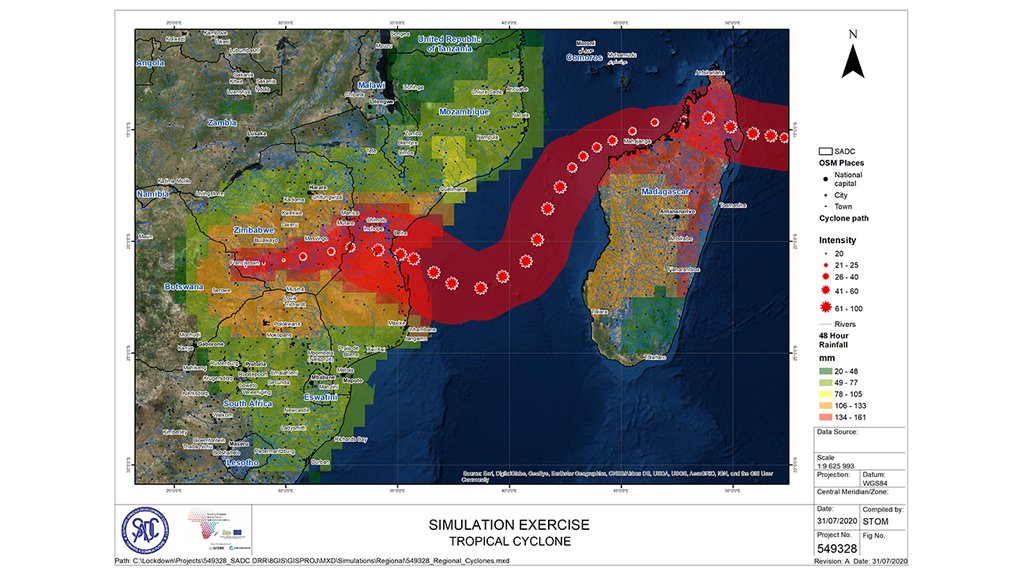Flood resilience must now be a key focus for S Africa




HERMAN BOOYSEN Careful attention to the municipal frameworks and regulations will go a long way to building resilience to disasters
TYPICAL CYCLONE PATH Countries in the Southern African region are regularly subject to cyclone events
ANDRIES FOURIE With climate change driving more variable weather patterns, the risk of similar events in future is growing
As flood events become more frequent and severe, South Africa will need to lift its game in disaster management to become more resilient.
This means not just better maintenance of infrastructure, but the building of the necessary expertise and resource base to recover more quickly from flood damage. According to international consultancy firm SRK Consulting disaster and risk management senior technologist Andries Fourie, there is a danger of entering a downward spiral owing to natural disasters.
“We can already see how countries in our region are regularly subject to cyclone events, and struggle to rebuild what has been lost. Even before they can recover from one devasting flood or cyclone, another will arrive and set them back even further.”
The recent flooding in KwaZulu-Natal – after unprecedented rainfall levels – has placed huge demands on disaster management agencies at municipal, provincial and national level. With climate change driving more variable weather patterns, the risk of similar events in future is growing, he warns.
“We need to understand the dangers of compounded and complex disasters, where there are multiple simultaneous impacts – each needing to be quickly addressed and then mitigated in future.
“Floods can cause immediate damage, which leads to displaced people being forced from their homes, for instance. “But soon there could be a health crisis as a lack of sanitation can lead to the rapid spread of water-borne diseases.”
Beyond the direct and indirect consequences of flooding could be an unrelated event such as a pandemic, which needs to be addressed simultaneously.
SRK Consulting principal geographic information scientist Dr Herman Booysen highlights the importance of properly implementing existing policies and frameworks as a vital pillar of building resilience.
“Much of a municipality’s disaster risk reduction is done through the Integrated Development Plan (IDP) and the Spatial Development Framework (SDF). These can provide the necessary guidelines and specifications for floodlines and floodwalls for new developments, for example. Where these frameworks are not competently prepared and fully implemented, the community becomes exposed to significant disaster risk.”
Among the purposes of the IDP is the identification of key projects to reduce risk to infrastructure and human life, he explains.
This could include improving the municipality’s resilience to flooding by installing or upgrading the stormwater infrastructure to channel water effectively away from areas at risk. Among the roles of the SDF is the specifying of requirements for development in various areas of the municipality, based on the local conditions and risk levels.
This demands that municipal officials approach these tasks in a disciplined and systematic manner, and ensure ongoing coordination between the relevant departments in a municipality – especially regarding disaster risk management.
“In addition to ensuring the application of the IDP and SDF, municipalities also need to draft and review these documents as required (the IDP is drafted every five years, reviewed yearly and the SDF is drafted every ten years, reviewed yearly) – especially in light of climate change.
“As rainfall patterns become more variable and intense, the infrastructure must be adapted and upgraded accordingly,” says Booysen.
He emphasises that timeous and well-considered expenditure on disaster risk mitigation will be more than paid back by the reduced spending required to recover from a natural disaster. The less prepared a community is for these events, the more damage will be caused and the longer the recovery will take. The cost of this disruption in terms of economic activity alone can be substantial, as was recently witnessed in KwaZulu-Natal.
“Careful attention to the municipal frameworks and regulations will go a long way to building resilience to disasters. By planning ahead and investing strategically in the right infrastructure, millions can be saved in future recovery efforts. “Most importantly, communities can get back to work more quickly – keeping up the economic momentum necessary for a speedy recovery before the next event,” Booysen adds.
Fourie says a fundamental starting point for many municipalities is to at least maintain their current levels of resilience by cleaning and maintaining stormwater infrastructure. He has witnessed system decay such as concrete panels on water canals coming loose, allowing scoring to quickly damage these facilities. Debris in canals also restricts the free flow of water, raising the risk of overflowing and damage to riparian zones and the surrounding area.
“Natural watercourses also need to be well maintained and cleared, with regular removal of trees and other large debris. “These can block the flow under bridges, for example, and cause flooding of river banks and road crossings – with associated damage.”
In Fourie’s experience, many municipalities are only doing “the basics” rather than planning ahead with preventative strategies that could enhance their resilience to disaster.
Booysen notes that a proactive approach is particularly necessary given the growing populations of many towns owing to urbanisation and migration. Widespread conditions of poverty also adds to communities’ vulnerability to natural disasters.
“The increased disaster risk facing communities today is, therefore, not only the result of greater frequency of heavy rainfall and flooding, it is also based on the reduced capacity of all levels of government to cope with the results. “Building this capacity is vital to creating more flood resilience,” he says.
Comments
Press Office
Announcements
What's On
Subscribe to improve your user experience...
Option 1 (equivalent of R125 a month):
Receive a weekly copy of Creamer Media's Engineering News & Mining Weekly magazine
(print copy for those in South Africa and e-magazine for those outside of South Africa)
Receive daily email newsletters
Access to full search results
Access archive of magazine back copies
Access to Projects in Progress
Access to ONE Research Report of your choice in PDF format
Option 2 (equivalent of R375 a month):
All benefits from Option 1
PLUS
Access to Creamer Media's Research Channel Africa for ALL Research Reports, in PDF format, on various industrial and mining sectors
including Electricity; Water; Energy Transition; Hydrogen; Roads, Rail and Ports; Coal; Gold; Platinum; Battery Metals; etc.
Already a subscriber?
Forgotten your password?
Receive weekly copy of Creamer Media's Engineering News & Mining Weekly magazine (print copy for those in South Africa and e-magazine for those outside of South Africa)
➕
Recieve daily email newsletters
➕
Access to full search results
➕
Access archive of magazine back copies
➕
Access to Projects in Progress
➕
Access to ONE Research Report of your choice in PDF format
RESEARCH CHANNEL AFRICA
R4500 (equivalent of R375 a month)
SUBSCRIBEAll benefits from Option 1
➕
Access to Creamer Media's Research Channel Africa for ALL Research Reports on various industrial and mining sectors, in PDF format, including on:
Electricity
➕
Water
➕
Energy Transition
➕
Hydrogen
➕
Roads, Rail and Ports
➕
Coal
➕
Gold
➕
Platinum
➕
Battery Metals
➕
etc.
Receive all benefits from Option 1 or Option 2 delivered to numerous people at your company
➕
Multiple User names and Passwords for simultaneous log-ins
➕
Intranet integration access to all in your organisation




















